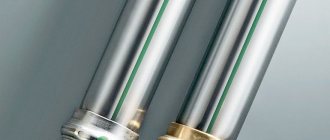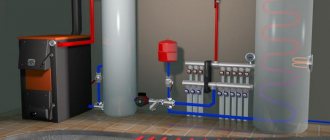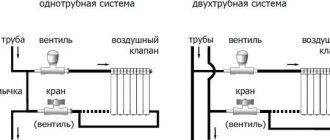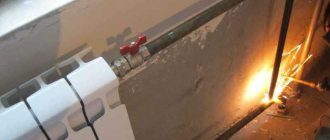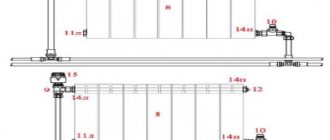General overview of radiator types and their dimensions
There are several main groups of heating batteries, differing in design features:
- Sectional.
- Panel made of steel and bimetallic.
- Convector.
- Author's models , made to order, having unique shapes, but performing their functions.
The photo shows the original heating device
The material used and the design features of the heating devices determine:
- resistance to water hammer;
- corrosion;
- clogging and scale deposits;
- heat transfer intensity and other components of success.
As for the size, the difference in height between the upper and lower collector (center distance) affects the possibility of installing the heating device. Most often they are installed in niches under windows; if the window opening is large enough, then the high battery simply will not fit.
The diagram shows the center distance
This parameter is especially important for systems with natural circulation. The fact is that the pressure in the system is created due to the difference in height between the water supply to the battery and the boiler; the greater this value, the greater the natural pressure in the pipes.
Note! For example, it makes sense to choose a center-to-center distance of 250 mm for heating radiators only for very low window sills. In this case, it will be possible to install batteries even under a window sill 50-60 cm high.
Example of a battery in a room with large windows
Panel heating devices are an all-welded structure with a coolant coil between two ribbed panels with a gap between them of up to 1 cm. Such a surface increases the area of the heated surface and its heat transfer - radiation plus convection. The meager capacity promotes rapid heat transfer - the efficiency reaches 75%, but they also cool down quickly.
The disadvantage of panel products is:
- their vulnerability to water hammer, which makes them unsuitable for use in central heating systems;
- corroded by acidic water;
- You cannot drain water for a long time due to the same corrosion, but in contact with oxygen.
Sectional batteries are good for the possibility of their design changes - increasing/decreasing the number of sections to change power or repair. Traditional brittle but durable cast iron with high inertness has been replaced by bimetallic devices.
In the photo - the device of a bimetallic heater
In them, the coolant passes through steel tubes with aluminum fins, which have high thermal conductivity.
A bimetallic battery is the embodiment of two advantages in one product, namely:
- steel can withstand unstable pressure and aggressive environments;
- aluminum reacts with lightning speed to temperature changes.
Note! The only drawback that can be noted is the cost. The price of a bimetallic radiator can be 2-3 times higher than an analogue made of cast iron or steel.
When choosing bimetallic batteries, you also have to take into account the diameter of the vertical and horizontal channels, and not just the interaxal distance. As for the dimensions, the most popular models can be considered those with a difference between the nipple holes of 500 mm (the total height of the heating device is 570 mm).
The photo shows the horizontal and vertical channels; if the quality of the coolant is poor, they should not be too narrow
But in vacuum batteries the concept of “center distance” simply does not exist. The fact is that they use only 1 flow pipe through which the coolant circulates, and uniform heating of the surface is achieved through the evaporation of a low-boiling liquid.
Tubular battery registers are superior to sectional ones in compactness and variety of shapes. The absence of leaks at the joints is ensured by welding the fragments; they can withstand operating pressures of up to 15 atm, but thin walls do not withstand water hammer well. It is quite possible to make the registers yourself by choosing an arbitrary pitch between the pipes.
What is the radiator center distance
It happens that an aluminum or bimetallic heating radiator selected for heat transfer does not fit under the window in height and length. But heating devices must not only be pushed into the existing opening, but also maintain the recommended distances to the wall, window sill and floor.
Otherwise, there will be little room for the movement of convection air flow and heating efficiency will decrease. The values of these distances are indicated on the product installation diagram:
In order to determine in advance the height of the heating device and its length, you need to know the required heat transfer and the dimensions of the window sill niche (if there is one). In addition, you need to understand that all aluminum and bimetallic heating radiators have one unified size - the center distance. This is the gap between two axes running along the horizontal collectors of the battery. How this concept differs from other dimensions of the heating device is clearly shown in the figure:
For reference. This pattern is valid for all types of metal radiators.
The standard center-to-center distance of heating devices, maintained by all manufacturers without exception, is 350 and 500 mm. Other models can be produced with axle spacing of 200, 600, 700, 800 and 900 mm. Other dimensions may be different, but in the vast majority of their sizes lie within the following limits:
- section length (visually – width) from 80 to 88 mm;
- depth – from 52 to 100 mm;
- The total (installation) height of the product with an interaxal distance of 500 mm is from 570 to 590 mm.
Note. The installation height values for products with other intervals can be seen on the website of the corresponding manufacturer; there is no point in listing them here.
Heating radiator sizes
Based on the type of material, radiators can be bimetallic, steel, aluminum or cast iron. The dimensions, general parameters and weight of the batteries directly depend on this, which must be taken into account when choosing the appropriate option.
Bimetallic
In appearance, bimetal batteries resemble aluminum devices, while their output and input collectors, as well as vertical heat-conducting channels, are made of stainless steel with an aluminum housing placed on top.
Devices of this type do not rust and are resistant to water hammer, so they are often installed in apartments that are connected to a central heating system. The list of advantages includes a high level of strength, reliability, resistance to environmental influences, and compatibility with all heating systems. Section dimensions:
- Center distance: 200 mm, 350 mm, 500 mm.
- Height: 415 mm, 570 mm.
- Width: 80 mm.
- Depth: 75 mm, 85 mm, 90 mm, 100 mm.
Radiators have high heat transfer, do not require a large number of thermal media, and their service life reaches 20-25 years. They also have their drawbacks, for example, creaking that occurs due to the difference in the expansion coefficients of steel and aluminum. Vertical channels can become clogged, so their cleanliness must be monitored separately; in addition, bimetallic channels are more expensive than analogues made from other materials.
Aluminum
Dimensions of aluminum radiators
Radiators of this type can be extruded or cast; the second option is more popular, since such devices are highly durable and not subject to corrosion. Aluminum batteries provide optimal thermal output, they are easy to install and transport due to their low weight, and they are also able to heat up as quickly as possible.
The models are available in a variety of designs and represent the optimal combination of cost and heat efficiency. The downside is the potential for damage due to water hammer. There are devices on the market with a gap between the axes from 200 to 800 mm, the most popular options being 350 and 500 mm.
Aluminum units can only be operated if there is no oxidized environment in the coolant, so they are not recommended for installation in buildings with a central heating system.
Steel
Appliances made of steel, including those with side connections, are tubular or panel.
Panel-type radiators are a system of 1, 2 or 3 panels with or without fins made of special U-shaped plates. Each panel includes a pair of steel sheets with channels that are connected to each other by welding. The advantages of such radiators include increased heat transfer, convenient installation, resistance to damage, safety, reasonable cost and impressive design. Tubular radiators consist of inlet and outlet manifolds, which are connected to each other using several rows of tubes with a thickness of at least 1.0-1.5 mm. All parts are connected by welding, which leaves no seams. The list of advantages of tubular radiators includes accelerated heating, resistance to aggressive environments and mechanical loads, water hammer, the ability to choose the shape and color of the battery, safety and environmental friendliness, and no problems during operation.
The distance between the centers of the radiator fittings is 300 or 500 mm. The depth of the product section is from 40 to 115 mm. The thickness of the steel does not exceed 1.5 mm.
Panel devices may not withstand water shocks during system checks and are often subject to corrosion. The disadvantages of tubular radiators include reduced heat transfer, the formation of leaks in welding areas and high cost.
Cast iron
Cast iron batteries are still popular due to their good resistance to high temperatures, lack of corrosion problems and durability. Devices of this type have extended channels that ensure ideal circulation of the coolant even during clogs. Cast iron radiators provide an accumulating effect and remain warm for a long time after the coolant supply has been stopped.
Types of radiator connections
If connecting the bottom method of connecting the radiator. it will be equipped with a special valve for temperature control, which will immediately provide the required temperature.
When connecting a steel radiator to the side, a standard scheme for circulating heat in the room is used, and such a connection is cheap and not at all remarkable or noticeable.
Fabrication with multiple panels will result in greater heat input. Various metal alloys can also be mounted to them, as a result the size of the base, which provides heat transfer, will increase.
Types of battery connections
However, these heating systems also have distinctive features, for example, weight. According to this criterion, they can reach the weight level of cast iron installations, which are quite heavy. Also, the volume of water will be a minus, which means that thermal regulation will be lower and, accordingly, heat transfer too. The thickness of the radiator can reach 160 mm, which exceeds the thickness of cast iron. In addition, the inner shell of such batteries is difficult to clean.
Products made from pipes help us remember the times of cast iron batteries. they are similar in external parameters. In most cases, the installation of cast iron batteries is carried out in administrative buildings and residential buildings of the Stalin period. They are resistant to strong atmospheric pressure up to 10, can reach more than one hundred cm in length, and a maximum width of 2 cm. They can also be sectional or non-sectional.
How tall are aluminum radiators?
The actual height of the heating radiator often does not correspond to that indicated in the specifications, instructions or data sheet. The fact is that manufacturers usually indicate the center-to-center distance between the centers of horizontal channels (see figure).
Height of the heating radiator and center distance.
It is important to know the center-to-center distance in order to design the location and installation of pipes. The actual height of an aluminum radiator is important when you are going to install it in a niche or under a window. In this case, it is necessary to take into account the height tolerances at the top and bottom. Read more about this in the article on the correct installation of heating radiators.
There are several standard center distance options for aluminum radiators:
- 30-35 cm;
- 50-55 cm;
- 60 cm;
- 90 cm.
The height of the section of an aluminum heating radiator may be 7-15 cm larger, depending on the design, manufacturer, etc. In addition, some models may have a non-standard center-to-axle distance, for example, 58.5 cm. But to determine which option is needed, approximate values will be enough.
Characteristics of electric radiators.
There is an alternative to central heating, it is an electric heating system. Such a system has a number of advantages: it heats well, is extremely easy to install, compact, and silent in operation. It is worth noting that an electric heating system is more economical than central heating and other heating systems, because... the cost of installing the system and the energy spent working is significantly lower. It is possible to regulate energy consumption depending on the time of day and outside temperature, which also contributes to savings.
Advantages of electric radiators:
Easy installation of the heating system; The system is environmentally friendly; Saves space because
electric heating radiators are very compact; The safety of using an electrical appliance is ensured thanks to the presence of special sensors; Fully autonomous operation with a standard supply voltage of 220 V; Thanks to their design, electric batteries will harmoniously fit into any interior; It is possible to select the number of electric battery sections, depending on the room parameters. Please note that it is necessary to decide on the choice of heating system at the building design stage. The main disadvantage of an electric convector is the cost of electricity
Electricity consumption directly depends on possible heat losses in the room - doors, type of double-glazed windows, window area, size and quality of room insulation
The main disadvantage of an electric convector is the cost of electricity. Electricity consumption directly depends on possible heat losses in the room - doors, type of double-glazed windows, window area, size and quality of room insulation.
Conclusion: If you are the owner of private houses and apartments that are equipped with autonomous heating systems, you can choose batteries based on your aesthetic preferences and financial capabilities, since the risk of water hammer in autonomous heating systems is usually small, and the coolant is of fairly high quality.
Aluminum radiator width
The width (length) of an aluminum radiator depends primarily on the number of sections. And the width of the aluminum radiator section is not a constant value. It depends on the model and manufacturer. And varies from 8 to 10.5 cm.
The width of the battery section determines how efficiently it will heat. The lower the temperature of the water or coolant in the system, the worse it warms up the aluminum feathers. Accordingly, the section should be narrower.
When connecting sections to each other, nipple nuts are used. Sometimes gaskets are installed at the joints or coated with sealant. Their thickness has virtually no effect on the overall dimensions of the radiator.
That is, to find out the dimensions of an aluminum heating radiator for 10 sections, it is enough to know its center distance and section width. Add 7-15 cm to the center distance - you will find out its real height. Multiply the width of the section to find out its length.
Low radiators
All heating devices whose center distance is less than 400 mm can be considered low. And here they offer many different models.
Steel panel radiators can be very low
In the cast iron group, the BOLTON 220 model with an installation height of 330 m has the minimum center distance, slightly higher than the Hellas 270 from Viadrus: it has an installation height of 340 mm. All the rest are taller - with an axle distance of 300-350 mm or so.
Among aluminum radiators, Sira has the smallest ones; their mounting height is 245 mm, and the center distance is 200 mm. These are Alux and Rovall models with a depth of 80 mm and 100 mm. Another well-known manufacturer Global has models of similar dimensions - the Gl-200/80/D model, and the Russian Rifar has the Base 200 and Forza 200.
All manufacturers have slightly larger aluminum batteries (with a center distance of 300 mm or more). There is a wide choice here.
The same Rifar and Sira have bimetallic low radiators: height 245 mm and 264 mm, respectively. But most of all there are models with connecting dimensions of 350 mm. Any manufacturer has them. This distance can also, in fact, be considered standard - everyone has it.
There is even more choice in the group of steel radiators. The smallest panel panels are produced by Purmo - Purmo Planora and Ramo Compact - their center distance is 150 mm and their height is 200 mm.
For all other manufacturers, the height starts from 300 mm. Moreover, the length can be up to 3 meters (the step of its change is 100 mm).
Connecting dimensions of aluminum heating radiators
All sections that make up the heating radiator are identical. Traditionally in heating, diameters are measured in inches. There are several standards for connecting sizes:
| Inches | Millimeters |
| 1/2 | 12.7 |
| 3/4 | 19 |
| 1 | 25.4 |
| 1 1/4 | 31.7 |
| 1 1/2 | 38.1 |
The most common radiators are for connecting to pipes with an outer diameter of 3/4 and 1 inch. They provide optimal water flow rate.
If you install a radiator with a small cross-section of pipes, the fluid flow rate will be too high and it will not have time to release heat. If the cross-section of the pipes is large, then the flow rate will be low and the radiator will silt up - particles of dirt from the water will accumulate in its lower part.
Important! The diameter indicated in the technical specifications of the radiator is internal. The outer diameter of the heating pipe or fitting must correspond to it.
How to calculate the size of radiators for a room
Knowing the basic characteristics of heating equipment and the area of the room, you can easily determine the required radiator power, and subsequently all the characteristics of the system, including the boiler.
Let's look at a similar calculation using a real example:
Let’s say a room with the characteristics of 4x3x2.7 is planned for installation of heating - a standard bedroom in a Soviet Khrushchev-era building.
First, let's calculate the volume of the room that will have to be heated: 4*3*2.7=32.4 m3. It is this volume of air that our radiator will have to heat.
Then you should determine how much heat will need to be spent to heat this volume. Without taking into account measures to increase energy efficiency (energy saving, wall insulation, etc.), the standard for the temperate climate zone of Eastern Europe is the cost of heating one cubic meter of 41 watts.
Accordingly, to heat our room you will need: 32.4 m3 * 31 Watt = 1.3 kV
This is the amount of energy that the air needs to receive from the radiator for heating. Next, knowing the required amount of heat, you can calculate the technical characteristics of the radiator that will be mounted.
Each radiator has a heat transfer characteristic. This is the amount of energy that the equipment is capable of releasing into the atmosphere while maintaining the quality indicators of the heating system. This figure may be underestimated, but cannot be exceeded. The radiator power is always indicated on the packaging, in the passport or certificate.
Heating our room will require 1.3 kW of energy. To prevent force majeure effects during abnormal frosts, the indicator is calculated with a margin of 15-20%. In total we have 1.5 watts.
One fin of a standard bimetallic radiator is capable of delivering up to 150-180 Watts of energy. Total: 1500/150=10. Those. To fully heat our room, we will need to install a 1.5 kW radiator, consisting of 10 fins.
If the walls are insulated and vacuum metal-plastic windows are installed, the actual energy consumption for heating can be reduced by 2 or more times. Accordingly, there is no point in purchasing a radiator of higher power.
Dimensions of aluminum radiators from various manufacturers and their models
The tables below show both the size of the aluminum radiator section and the dimensions of the assembled radiators.
Aluminum radiators ROVALL
This company, part of the Sira Group, makes aluminum batteries with a distance between the collectors of 50, 20 and 35 cm. The kit for their installation (which is purchased separately) should include adapters, plugs, nipples with gaskets (for connecting sections), brackets for wall mounting and Mayevsky crane.
Country of origin: Italy.
Main parameters:
- Maximum operating pressure – 20 bar.
- The pressure when testing the device is 37.5 bar.
- The water temperature limit is 110 °C.
Characteristics of Rovall Alux 200 - distance between axles 200 mm:
ModelDimensions (H/D/D), mmPower of the entire radiator, WNumber of sections
| ALUX 200/1 | 245 / 100 / 80 | 92 | 1 |
| ALUX 200/4 | 245 / 100 / 320 | 368 | 4 |
| ALUX 200/6 | 245 / 100 / 480 | 552 | 6 |
| ALUX 200/8 | 245 / 100 / 640 | 736 | 8 |
| ALUX 200/10 | 245 / 100 / 800 | 920 | 10 |
| ALUX 200/12 | 245 / 100 / 960 | 1104 | 12 |
| ALUX 200/14 | 245 / 100 / 1120 | 1288 | 14 |
| ALUX 200/16 | 245 / 100 / 1280 | 1472 | 16 |
* All data is taken from official sources of manufacturers.
Characteristics of Rovall Alux 350 - distance between axles 350 mm:
ModelDimensions (H/D/D), mmPower of the entire radiator, WNumber of sections
| ALUX 350/1 | 395 / 100 / 80 | 138 | 1 |
| ALUX 350/44 | 395 / 100 / 320 | 552 | 4 |
| ALUX 350/6 | 395 / 100 / 480 | 828 | 6 |
| ALUX 350/8 | 395 / 100 / 640 | 1104 | 8 |
| ALUX 350/10 | 395 / 100 / 800 | 1380 | 10 |
| ALUX 350/12 | 395 / 100 / 960 | 1656 | 12 |
| ALUX 350/14 | 395 / 100 / 1120 | 1936 | 14 |
| ALUX 350/16 | 395 / 100 / 1280 | 2208 | 16 |
* All data is taken from official sources of manufacturers.
Characteristics of Rovall Alux 500 - distance between axles 500 mm:
ModelDimensions (H/D/D), mmPower of the entire radiator, WNumber of sections
| ALUX 500/1 | 545 x 100 x 80 | 179 | 1 |
| ALUX 500/4 | 545 x 100 x 320 | 716 | 4 |
| ALUX 500/6 | 545 x 100 x 480 | 1074 | 6 |
| ALUX 500/8 | 545 x 100 x 640 | 1432 | 8 |
| ALUX 500/10 | 545 x 100 x 800 | 1790 | 10 |
| ALUX 500/12 | 545 x 100 x 960 | 2148 | 12 |
| ALUX 500/14 | 545 x 100 x 1120 | 2506 | 14 |
| ALUX 500/16 | 545 x 100 x 1280 | 2840 | 16 |
* All data is taken from official sources of manufacturers.
Aluminum radiators Climatic Control Corporation LLP
The brainchild of this company is BiLUX AL radiators with excellent heat output, which are made taking into account all the nuances of individual heating systems. Their surface area is very significant, and the cross-section of the vertical pipe is optimally calculated. The factory for the production of these radiators is located in China. The distance between the axes of the collectors can be 30 cm (BiLUX AL M 300) or 50 cm (BiLUX AL M 500).
During the manufacturing process, the injection-molded upper parts are connected to the bottom, which is made using a special welding technology. After assembly, the batteries are processed chemically and mechanically. They are then tested to see how tight and durable they are. Batteries are painted in several stages. After cleaning, they are exposed to an electrostatic field. At this time, enamel based on epoxy resin is sprayed. Then, by heating to a high temperature, the surface of the product is polymerized.
Features of bimetallic radiators
The second option that the store can offer you is a bimetallic radiator. The prefix “bi” in the word “bimetallic” means “two”. This name is given to this type of battery because they are made from two metals: steel and aluminum.
Let's immediately turn to the positive characteristics of this species:
- The steel in the material from which the body is made will perfectly withstand any surges in water pressure. It is also not subject to corrosion. These properties of the metal ensure high strength and many years of faithful service of the device;
- steel sheet provides serious protection of the case from external mechanical damage;
- active coolant circulation;
- Aluminum coating will ensure rapid heating of the air in the living room;
- battery operating pressure can reach 40 atm;
- the maximum possible coolant temperature is approximately 130 degrees, while for aluminum products it is only 110;
- durable paint coating on the body. This stability is achieved through a two-stage dyeing mechanism:
- First of all, the product is placed in a dye solution and completely covered with paint;
- Then another polymer layer based on epoxy resin is sprayed on top of the dried first paint. Radiators processed using this technology not only look very aesthetically pleasing, but also take on clearer geometric shapes;
easy installation and transportation, especially if you seek the help of professionals. The design of bimetallic batteries is no more complicated than that of simple aluminum ones, however, their installation is also best left to professionals. How long the batteries are installed correctly, the longer they will serve you; the ability to add additional sections directly to your home
However, if you assume that you still want to increase their number, when purchasing, pay attention to the design of the radiator housing. Some of the models on the market have a solid steel core, so they are not divided into sections.
Bimetallic radiator section
One of the options for the appearance of a bimetallic radiator
Let's pay attention to the disadvantages of bimetal devices:
- aluminum used in combination with steel loses its high heat-transfer properties. Due to the steel core inside the battery, you will have to wait a little longer than you are used to for the air to reach the desired temperature;
- increased price. Since the price of steel is higher than silicon, the cost of bimetallic batteries also increases by about 30% compared to aluminum ones;
- increased operating costs. Since bimetallic devices boast increased hydraulic resistance, the amount of energy spent on water circulation will also increase;
- Improper use of radiators can lead to corrosion of its steel parts. This will definitely happen if bimetallic batteries are installed in your dacha, which is not used in winter. As soon as the autumn heating season comes to an end, it will be necessary to carry out the procedure of draining the water from the system. It is because of this that corrosion processes will begin: simultaneous contact of steel with air and water instantly starts them.
- The small tube passage inside the device is subject to rapid clogging. This shortens the service life of the device.
Important! The coefficients of thermal expansion of steel and aluminum differ, which is why the battery begins to emit loud crackling sounds after a short period of time. This sound does not mean that there is a problem inside the device.
Don't worry, your health is safe!
These modern radiators can function properly even in rooms where the air humidity level is high. Their surface is resistant to corrosion. The radiator is given such resistance to aggressive environmental influences by sheet steel, which covers the body of the device with a protective layer.
Inside bimetallic radiators there are water channels of small cross-section. Due to their modest size, they are filled as quickly as possible with hot water coming from a centralized water supply system or an autonomous boiler.
Construction professionals consider purchasing bimetallic batteries and installing them during renovations as one of the best functional improvements to an apartment. Over time, the use of these devices will fully pay for the money spent on them.
Section calculation method
To determine the required number of elements, you need to determine the power. There are several rounded values calculated for a room with a ceiling height of 2.7 meters:
- For a standard room you need 100 watts.
- For each window add 10.
- If it is angular, the value is multiplied by 1.2.
- If the ceilings are higher or the windows are larger than usual, add 10%.
- Heating weakens from the upper floors to the lower ones, so another 2% should be added for each.
The resulting standard power is multiplied by the area of the room . The result is a total value calculated with a margin.
Then the number is divided by the passport indicator of one section , rounding up. An example calculation looks like this:
- (100 + 10) * 1.2 * 1.04 = 137.28 , where the extreme multiplier is chosen for the apartment on the third floor from the top.
- 137.28 * S = 151 * 18 = 2471, where S (18) is the area.
- 2471 / 190 = 13. In this case, with a power of one section of 190 Watts, 13 pieces will be needed.
Radiator manufacturers
Once you have already decided on the type of radiator and its power, then you will be faced with the next question - “ Which manufacturer to choose from the large variety offered on the Russian market, which one is better?” There is, of course, no clear answer here. The main thing to note is that the best radiators are made in Europe and most of them are made in Germany and Italy.
If you want to make the right decision and buy a truly reliable and durable radiator, the best thing you can do is consult with us. We cannot openly say which manufacturers are better and which are worse. But we always recommend to our clients what will last longer. And we know more about this than anyone.
Radiator weight
Aluminum is a lightweight metal. Products made from this material are lightweight, which makes them easier to move and reduces the strength . It should be noted that in the manufacture of batteries, metal is fused with silicon. This slightly increases the severity.
The average weight of one section is 1.25 kg. The value varies from 1 to 1.35, which depends on the dimensions and wall thickness. For example, to install a radiator of 10 units with a small margin, 15 kg of fasteners are sufficient.
Important! Of all types of radiators, aluminum ones are the lightest. This makes them easy to transport.
Methods for connecting radiators
Of course, in order for steel heating radiators to perform their functions, they must be properly integrated into the system. Panel radiators can be connected from below or from the side. When choosing radiators, you need to think very carefully about their connection diagram - in some situations you have to combine the bottom connection with the side connection.
The bottom connection has a characteristic advantage - radiators installed in this way allow you to hide the pipes under the floor or in the walls, or to place them at a minimum distance from the floor. You have to pay for this advantage - the cost of devices with a bottom connection is an order of magnitude higher than more traditional batteries with a side connection. Iron heating radiators connected from below are marked with the letter “V”.
Connecting radiators from the side has two important advantages:
- Firstly, installation of the side connection is much simpler than the bottom one;
- Secondly, with proper installation, the side connection will ensure full heat transfer (for comparison, with a bottom connection, the level of heat loss can reach 20%).
